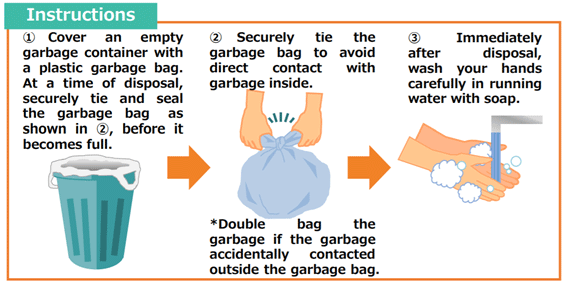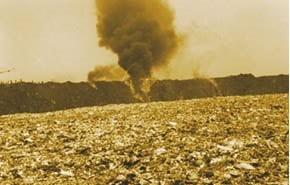- Waste management in Japan
- Circular economy in Japan
- Waste management in Asia
- Disaster waste management
Rethinking the Sound Material-Cycle Society during the Novel Coronavirus Pandemic: Importance of Waste Management from Public Health Perspective
Necessary waste management measures during the COVID-19 pandemic
As of April 2020, at the time of writing this article, the novel coronavirus (COVID-19) has been spreading around the world. Our research subject, the sound material-cycle society and waste management, may appear irrelevant to infectious disease countermeasures, but in fact, they are closely related.
Since January 2020, the Ministry of the Environment of Japan (MOEJ) has been urging households and medical institutions to properly dispose of waste (MOEJ, 2020). As for households, if a household with any member infected or suspected of being infected with COVID-19 is disposing of used facemasks and tissues, they are requested "not to directly touch the waste," "to securely tie the waste bags," and "to wash their hands after disposing of the waste." The ministry states that these disposal methods are similar to those applied in the case of influenza infection, and that they can effectively protect not only household members but also municipal and waste treatment company personnel who handle household waste. As for medical institutions, the ministry has informed them that infectious waste related to COVID-19 can be handled in the same way as other infectious waste.
Based on the experiences from the 2009 influenza H1N1 and the 2014 Ebola virus pandemics, the MOEJ published in 2018 "Infectious Waste Treatment Manual under the Waste Management and Public Cleansing Law" to specify proper waste treatment/disposal methods and systems. The ministry also had "Guidelines for Measures against New Influenza in Waste Treatment" (2009) to show how waste treatment companies and other parties involved in waste management can prepare and implement measures such as business continuity plans. Facing the current COVID-19 pandemic, the ministry has disseminated these previously published guidelines once again. Securing business continuity even during the spread of these diseases is of particular importance that all these guidelines highlight in common, besides protection of waste treatment personnel from getting infected. The current COVID-19 pandemic suggests the importance of maintaining medical systems. Moreover, we need to realize that waste treatment is also an essential service for maintaining citizens' lives. The spread of the virus has raised concerns over increased discharge of disposable containers and leftover food waste, and deterioration of cleaners' working environment due to a shortage of facemasks. All these problems need to be handled carefully and properly.

Japan's waste management began from public health needs
The following is a brief overview of the history of Japan's efforts toward sound material-cycle society (MOEJ 2014). According to the MOEJ, the history is broadly divided into three parts: the era of "public health improvement" (up to the 1950s), the era of "pollution problems and protection of living environment " (1960s-1970s), and the era of " establishment of a sound material-cycle society" (1980s-2000s). Japan's waste management began from public health needs.
Clean Authority of Tokyo's website provides details of Japan's waste management history. It states that, at the end of the Edo period, Japan's increased contact with foreign countries caused cholera epidemics, and led to many deaths, far exceeding the number of those in the Sino-Japanese War and the Russo-Japanese War. The Authority explained that the cholera epidemics led Japan to start promoting cleaner waste disposal methods. We may be able to find a lesson from this historic event and apply it to the present-day situation: the spread of COVID-19 infections due to globalization, and a growing need for proper waste management as a measure to prevent further damage. Clean Authority of Tokyo continues the story. In 1930, the waste management law of that time made it mandatory for municipalities to incinerate the waste they collect. However, construction of waste treatment plants (i.e., incineration facilities) could not keep pace with a rapid increase in waste generation. It caused many problems in public health such as swarms of flies over urban garbage in a landfill site called "Yume-no-shima" (Dream Island) in Tokyo. In July 1965, the Tokyo Metropolitan Government implemented a special operation to burn to the ground large piles, or "cliffs," of the garbage with a height of about 20 meters and a width of about 270 meters. In 1971, then Tokyo Governor declared "war against garbage" and implemented measures even more aggressively, and the turmoil finally came to an end. In this way, the need for securing public health and preserving citizen's safe living environment drove forward the waste incineration in Japan. Around the same time, the Waste Management and Public Cleansing Law (i.e., the current law) was enacted in 1970.
 Photo 1: A landfill site in the 1960s with a helicopter spraying insecticide to prevent fly infestations.
Photo 1: A landfill site in the 1960s with a helicopter spraying insecticide to prevent fly infestations. Photo 2: Operation Yume-no-shima scorched earth, 1965
Photo 2: Operation Yume-no-shima scorched earth, 1965Responding to changing policy agenda while promoting waste incineration
In the 1980's, Japan's waste management policy continued to promote the incineration method from the viewpoint of public health. From around that time, public concerns gradually increased over dioxin emissions from incineration plants. In 1997, revisions of the Waste Management and Public Cleansing Law and relevant orders/ordinances obliged the incineration plant operators to install complete combustion and exhaust gas treatment facilities, and as a result, dioxin emissions were largely reduced. While the role of waste incineration became even more important in terms of controlling hazardous substances, waste treatment plants were still considered to be nuisance facilities. Therefore, improving the facilities and gaining understanding of residents near the plants became a major issue.
Meanwhile, the efforts toward a sound material-cycle society gained momentum. The Basic Law for Establishing a Sound Material-Cycle Society (referred to as "the SMC Law" in this article), enforced in 2001, prioritized actions for cyclical use of resources and management of waste. They are, from the one with the highest priority, (1) reducing generation of waste, (2) reusing, (3) recycling, (4) heat recovery, and (5) proper disposal (including simple incineration). In addition, other recycling laws including the Containers and Packaging Recycling Law (enforced in 1997) and the Home Appliance Recycling Law (enforced in 2001) advanced recycling of individual products and materials. However, Japan is sometimes criticized for having higher waste incineration rate and lower recycling rate compared to other developed countries (NIES Social Dialogue and Collaboration Promotion Office 2017).
Around 2000, reducing carbon dioxide (CO2) emissions from waste incineration became an issue also from the viewpoint of preventing global warming. As mentioned above, the SMC Law placed a rather low priority on "energy recovery" (i.e., heat recovery). The priority order of energy recovery was somewhere between "recycling" (the third highest priority) and "simple incineration" (the lowest priority). However, waste incineration with energy recovery was gradually recognized as a method of recycling. For example, the Cabinet Office's Specialist Committee on Circular Economy and Society treated thermal recycling and material recycling equally in its meeting in November 2001. In this way, Japan continued to promote waste incineration while properly responding to the issues of securing public health, minimizing dioxin emissions, and mitigating global warming. In Europe, meanwhile, the European Union's revised Waste Framework Directive (2008/98/EC) set out the following priorities (from the highest): (1) prevention, (2) preparing for re-use, (3) recycling, (4) other recovery (e.g. energy recovery), and (5) disposal. It specified that energy recovery would not be included in recycling.
Recent challenges in creating a sound material-cycle society and reaffirmation of public health perspective
In recent years, international concerns about marine plastic pollution have been mounting. This may be because various estimations were published one after another on this subject around 2015 as that of 4.8-12.7 million tons of plastic waste flowing into the ocean every year, or that of more plastics in the ocean than fish by 2050. This issue has posed a serious challenge for many researchers in the field of material cycles and waste management who have been responding to public health needs, improvement of waste treatment facilities, control of hazardous substances such as dioxins, mitigation of global warming and various other issues. Considerations for the finite nature of global environment were presented in such publications as "The Limits to Growth" (1972) and the "Planetary Boundaries" (2009). How to reduce plastic waste flowing into the ocean has also become a new and significant issue. In 2019, Japanese government formulated the National Action Plan for Marine Plastic Litter and the Resource Circulation Strategy for Plastics to strengthen measures toward a sound material-cycle society. These national policies call for not only the on-going "reduce, reuse, and recycle" efforts for plastics but also large-scale introduction of biomass-derived plastics.
Another challenge is how to ensure proper waste management at the time of disasters. Natural disasters have been becoming more severe and frequent with climate change. Some disasters generate a massive amount of disaster waste and cause damage to waste treatment facilities. From public health perspective, however, prompt and proper treatment of disaster waste is imperative. Therefore, it is necessary to make waste treatment facilities more disaster-resistant and maintain waste management functions. Such a measure is a key to securing public health.
The current situation, where almost all socioeconomic activities are severely affected by the COVID-19 pandemic, has made us reflect again on what a sound material-cycle society should aim for. As we find in the MOEJ's COVID-19 guidelines mentioned in the first section of this article, the need for securing public health, including responses to infectious diseases, and the importance of maintaining waste management functions have been recognized once again. These two aspects may be minimum requirements for the creation of a sound material-cycle society. In addition to these, more multifaceted and balanced measures, such as promoting the cyclical use of resources, mitigating global warming, preventing marine pollution, and responding to disasters, are called for.
For more information
- Ministry of the Environment of Japan (2014) History and Current State of Waste Management in Japan (external link)
- Clean Authority of Tokyo (external link)
- Social Dialogue and Co-production Office, National Institute for Environmental Studies (NIES), Japan (2017) What you need to know: the fact about recycling and waste management in Japan (in Japanese)
- Ministry of the Environment of Japan (2020) Measures for COVID-19 (external link)


